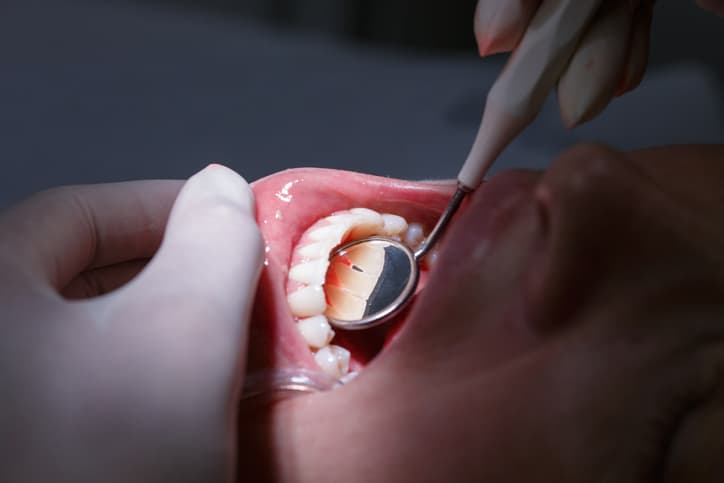 White, sparkling teeth are not the only sign of a healthy mouth. Your gums are a barrier that helps prevent inflammation that may damage your body. Gum disease has been linked to health problems such as diabetes, heart disease, stroke, and premature births or low-birth-weight babies.The good news? With daily brushing and flossing, and regular check-ups, most people can prevent gum disease. Here are answers to top questions about gum disease.
White, sparkling teeth are not the only sign of a healthy mouth. Your gums are a barrier that helps prevent inflammation that may damage your body. Gum disease has been linked to health problems such as diabetes, heart disease, stroke, and premature births or low-birth-weight babies.The good news? With daily brushing and flossing, and regular check-ups, most people can prevent gum disease. Here are answers to top questions about gum disease.What is gum disease?
Just as your skin protects your muscles, bones, and major organs, your gums help protect your teeth and the structures that hold them in place. Gum disease, also known as periodontal disease, starts when plaque, made up of bacteria, mucus, and food particles, invades the small space between your gums and teeth. If left to fester, your gums can become infected, putting them and your teeth at risk. If gum disease progresses, it can become increasingly difficult, painful, and expensive to treat.
What are the stages of gum disease?
- Gingivitis is the earliest stage of gum disease. At this stage, gums become red and inflamed and may bleed easily. Gingivitis can usually be turned around with a regimen of daily brushing and flossing, along with regular dental check-ups and cleanings — but it does need to be caught early.
- Periodontitis is a more serious stage of gum disease that can seriously damage the gums and structures that support the teeth. One of the hallmarks of periodontitis is pockets that form when gums pull away from the teeth. The bone and ligament that support the tooth start to break down and over time, the tooth becomes loose in its socket. Without treatment, the tooth could eventually have to be removed.
Besides what it does to the mouth, gum disease has been linked to conditions such as diabetes, heart disease, stroke, and premature births or low birth weight. According to Sally Cram, DDS, PC, consumer advisor for the American Dental Association, emerging research pinpoints inflammation. “They’re finding the role of inflammation in the body is very critical to a lot of these different diseases,” Cram tells. “And that’s essentially what gum disease is: infection and inflammation in the oral cavity.”
How many people have gum disease?
The U.S. Department of Health and Human Services estimates 1 in 7 adults between the ages 35 and 44 have some form of gum disease, from gingivitis to severe periodontitis. By age 65, 1 in 4 adults has gum disease. A report by the American Academy of Periodontology estimates 20% to 30% of adults have gum disease serious enough to put them at risk of losing teeth.
What are the signs and symptoms of gum disease?
Here are symptoms to watch out for.
- Swollen or red gums
- Gums that are tender or bleed easily
- Chronic bad breath
- Areas of gum that appear to be pulling back from the teeth
- Pain when chewing
- Sensitive teeth
- Teeth that are loose
How do you treat gum disease?
The stage of gum disease will determine how it is treated. In all cases, however, the goal will be to bring any infection under control and prevent further damage.
- Scaling and root planing. For less severe cases of periodontitis, the dental professional will remove infection-causing plaque with a method called scaling and root planing. It is essentially a deep cleaning method that removes bacteria from around the gum line and on the tooth root.
- Medications. Sometimes antibiotics or antimicrobial medications can reduce the size of gum pockets. These come in the form of mouth rinse, gel, pills, or tiny round particles that the dentist places directly in the pocket.
Surgery. If deep cleaning and medication do not return infected gums to a state of health, surgery may be the next step. There are two types of surgery. Flap surgery lifts away gum tissue so the dentist can clean underneath it; then the tissue is sutured back in place. Gum or bone graft surgery grafts tissue or bone from another part of your mouth onto the damaged part of your gum or jaw.
How can you prevent gum disease?
“You can save yourself a whole lot of problems: pain, money, aggravation, by just doing simple preventive things,” says Cram. Caring for your gums involves:
- Brushing your teeth twice a day
- Flossing once a day
- Seeing your dentist for regular check-ups and cleanings
Even if you brush and floss without fail, a professional cleaning can remove tartar that your toothbrush cannot. While two cleanings a year works for some people, your dentist or hygienist may suggest a more frequent schedule if your gums and teeth show signs of damage.
